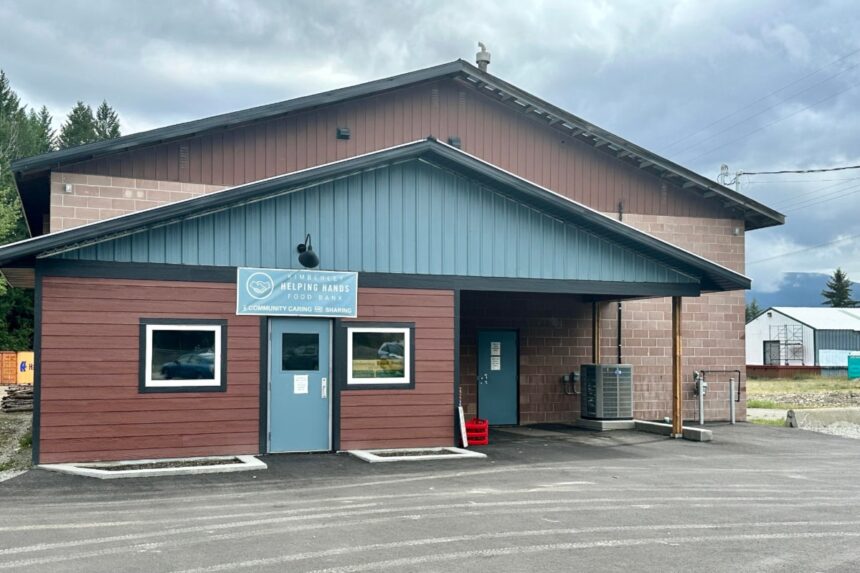I feel the ground shifting at Kimberley’s Food Bank these days. The small workspace buzzes with activity as volunteers sort through donations, but there’s a palpable tension in the air. The shelves aren’t as full as they used to be, yet more people are coming through the doors each week.
“We’re seeing nearly double the client visits compared to this time last year,” explains Heather Smith, coordinator at the Kimberley Food Bank. She gestures toward the intake desk where two volunteers are helping a young family. “And our volunteer numbers just haven’t kept pace with that growth.”
The Kimberley Food Bank, which has operated out of its current location on Wallinger Avenue since 2016, now serves approximately 300 households monthly throughout Kimberley and the surrounding communities. That’s up from about 180 families last year, according to their quarterly report shared with community partners.
Smith isn’t alone in noticing this trend. Food Banks Canada reported that nearly 2 million Canadians accessed food banks in March 2023, representing a 32 percent increase from pre-pandemic levels. The rising cost of groceries, housing, and utilities has pushed many families who were previously managing to seek assistance for the first time.
During my visit on a Tuesday morning, I notice only four volunteers handling what should ideally be a six-person operation. They move efficiently between stations, but the strain shows. One volunteer, Richard Dalton, 68, has been helping at the food bank for over five years.
“We’re managing, but just barely,” he tells me while organizing produce donations. “Some days I’m pulling double shifts because there’s nobody to relieve me. But I keep coming back because I know how important this service is to our community.”
The food bank is currently looking for volunteers to fill a variety of roles. They need people who can commit to regular shifts, particularly on Tuesdays and Thursdays when the facility is open to clients. Tasks range from stocking shelves and sorting donations to helping clients navigate the facility and loading vehicles.
“We’re not asking for huge commitments,” Smith emphasizes. “Even a few hours twice a month makes a tremendous difference.”
The volunteer shortage comes at a challenging time. With inflation hovering around 3.8 percent according to the latest Statistics Canada data, food prices continue to strain household budgets. In Kimberley, where seasonal employment fluctuates with tourism patterns, many working families find themselves needing occasional support.
City councillor Sandra Roberts, who chairs the community services committee, expressed concern about the situation during last month’s council meeting. “Our food bank provides an essential service that helps keep our community strong. We need to ensure they have the support they need to continue their work.”
The food bank does more than distribute food. They connect clients with additional resources, host nutrition workshops, and work with local producers to provide fresh options. All these programs require volunteer support.
“I started volunteering after I retired last year,” says Marian Chen, who helps coordinate donation pickups. “It’s been eye-opening to see how many of our neighbours are struggling, including people you’d never expect. There’s a dignity in how this place operates that I’m proud to be part of.”
For those interested in volunteering, the commitment can be tailored to individual schedules and abilities. Some volunteers work directly with clients, while others prefer behind-the-scenes roles like inventory management or administrative support. The food bank provides training for all positions.
During my conversation with Smith, a local contractor drops off several boxes of non-perishable items collected at a job site. “This helps, but we need consistent support,” she says. “Both donations and volunteer hours.”
The East Kootenay Community Credit Union recently announced a matching campaign for donations to the food bank, offering to match community contributions up to $5,000 through the end of the month. Corporate support like this helps with operational costs, but the volunteer shortage remains a critical issue.
As I prepare to leave, Smith hands me a simple volunteer application form. “Just in case you know someone who might be interested,” she says with a smile that acknowledges the journalistic boundary. “Sometimes people just need to be asked directly.”
For Kimberley residents interested in volunteering, the food bank can be contacted directly at their Wallinger Avenue location during operating hours, or through their community partners like the Healthy Kimberley Food Recovery Depot.
As winter approaches, typically bringing higher utility bills and seasonal unemployment for some sectors, the need for food bank services is expected to increase further. Whether through volunteering time or donating resources, the opportunity to support this vital community service has never been more important.
The volunteer shortage at Kimberley Food Bank reflects a broader challenge facing community organizations across Canada. As demand for services grows, finding enough hands to do the work becomes increasingly difficult. But as volunteer Richard Dalton reminded me before I left, “This community has always shown up when it matters most. I believe they’ll show up again.“






